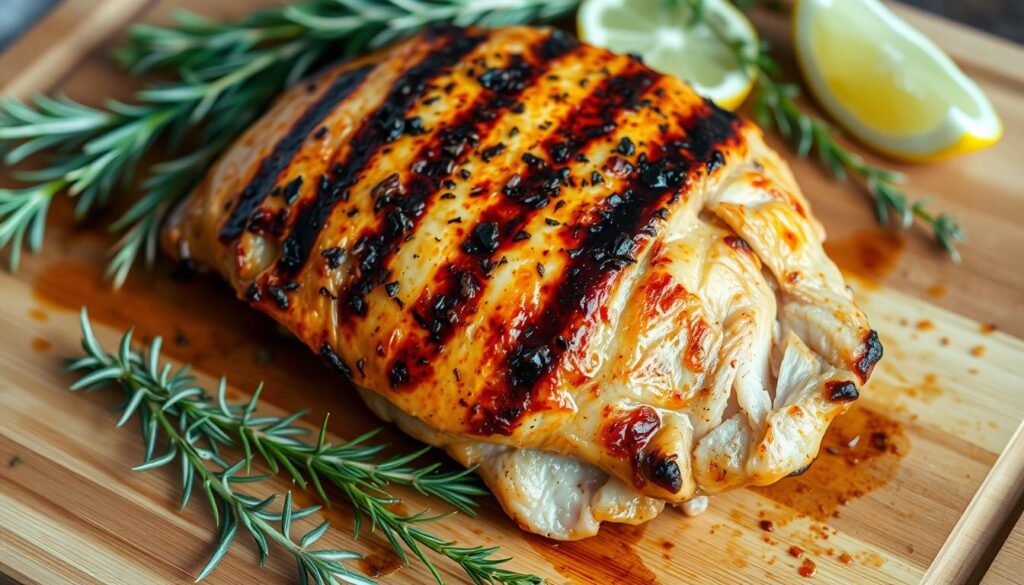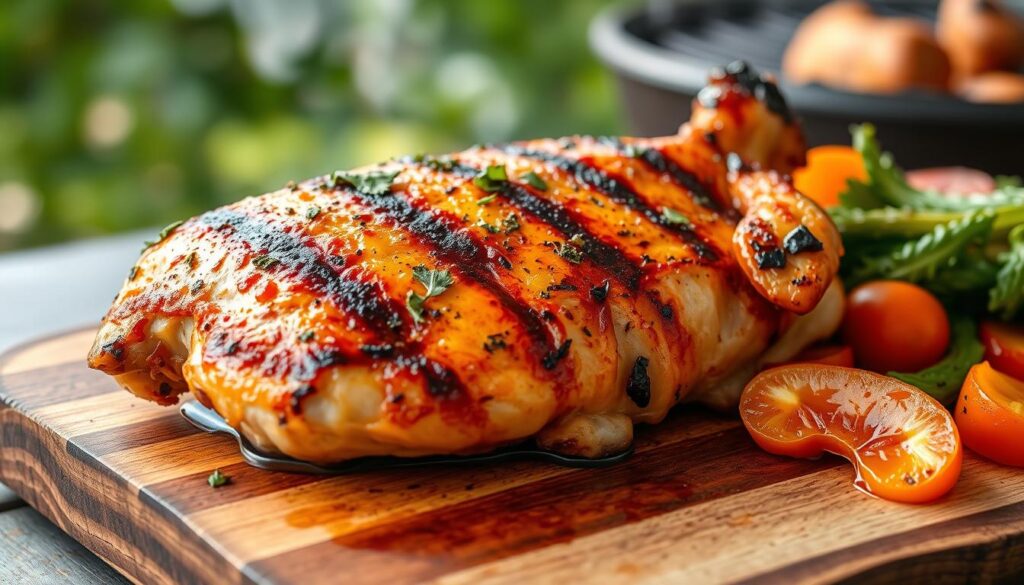Grilled chicken is a favorite for many, perfect for cookouts, family dinners, and casual get-togethers. Bone-in chicken breasts bring unmatched flavor and keep the meat moist. This guide will show you how to make your grilled bone-in chicken breast the best it can be.
Table of Contents
Understanding the Appeal of Bone-In Chicken
Bone-in chicken breasts have a big advantage when grilling. The bones add flavor and keep the meat moist. This makes them better than boneless chicken.
Benefits of Cooking with Bone-In Cuts
The bones in chicken breasts help cook the meat evenly. They prevent it from drying out. The marrow in the bones also adds a rich, savory taste.
Why Bone-In Breasts Are Superior for Grilling
Grilling bone-in chicken breasts makes them juicy and flavorful. The bones help cook the meat slowly and evenly. The high heat also makes the outside crispy and flavorful.
Flavor Profile and Moisture Retention
The bones in chicken breasts add flavor and keep the meat moist. As the chicken cooks, the bones release nutrients and marrow. This infuses the meat with a deeper, richer taste.
“Grilling allows excess fat to drip off the meat, making it a potentially healthier cooking method.”
| Cooking Method | Cooking Time | Advantages | Disadvantages |
|---|---|---|---|
| Grilling | 10-30 minutes |
|
|
| Baking | 20-45 minutes |
|
|
Essential Equipment and Tools for Perfect Grilling
Grilling bone-in chicken breasts to perfection requires the right tools. You’ll need a gas or charcoal grill, a meat thermometer, tongs, and a basting brush. These tools help you achieve the best taste and texture.
A two-zone grilling setup is key. It has a direct heat zone for searing and an indirect zone for slow cooking. This method ensures a crispy skin and juicy, flavorful chicken.
| Essential Grilling Equipment | Why It Matters |
|---|---|
| Gas Grill or Charcoal Grill | Provides the necessary heat source for grilling chicken. |
| Meat Thermometer | Ensures the chicken is cooked to the proper internal temperature of 165°F. |
| Tongs | Allows you to handle the chicken safely and avoid piercing the meat, which can lead to moisture loss. |
| Basting Brush | Helps you evenly apply oils, marinades, and sauces to the chicken during grilling. |
With the right equipment, you can master grilling. Enjoy delicious grilled chicken and other cooking techniques every time.
Preparing Your Chicken for the Grill
Getting your chicken ready for grilling is crucial for delicious results. First, clean the chicken well and dry it with paper towels. Remove any extra fat and the rib section for even cooking. You can choose between a tasty dry rub or a zesty marinade for seasoning.
Dry Rub vs. Marinade Options
A dry rub is quick and easy. Mix your favorite spices like garlic powder, smoked paprika, and brown sugar. Rub it all over the chicken. For deeper flavors, try a marinade. Let the chicken soak in a mix of acids, herbs, and spices for 30 minutes to 24 hours.
Temperature Considerations Before Grilling
Let the chicken reach room temperature before grilling. This helps cook it evenly, so the outside doesn’t burn before the inside is done. Aim for a grill heat of 375-400°F (190-204°C) for the best taste and texture.
Food safety is very important. The USDA says to cook chicken to 165°F (74°C) to kill bacteria. Let the grilled chicken rest for 5-10 minutes before slicing. This makes it tender and full of flavor.
The Science Behind Grilled Bone-In Chicken Breast
Grilling bone-in chicken is a delicate art. It requires understanding heat transfer and protein behavior. The key to juicy, flavorful results is using the unique properties of bone-in cuts.
The bone in chicken breasts is not just for looks. It plays a big role in cooking. The bone conducts heat slowly, cooking the meat evenly. This prevents the outside from getting too dry while keeping the inside moist and tender.
As bone-in chicken cooks, the Maillard reactions create flavorful compounds. This browning process, known as the “char” or “sear,” boosts the dish’s taste and smell. The bone also helps keep the meat juicy, making it succulent.
“The science behind grilling bone-in chicken is all about understanding heat transfer and protein behavior. The bone acts as a natural heat conductor, allowing for more even cooking and enhanced flavor development.”
By using this scientific approach, you can bring out the best in bone-in chicken breasts. You’ll get a juicier, more flavorful meal. This shows the true essence of bone-in meat and expert cooking techniques.
Maximizing Flavor and Texture
Grilling bone-in chicken breasts is about finding the right balance. Here are some key factors to consider:
- Gradual heat transfer from the bone helps prevent overcooking the exterior while ensuring the interior remains moist.
- Maillard reactions on the surface create a flavorful crust, enhancing the overall taste and aroma.
- The bone’s ability to retain moisture helps the meat stay juicy and tender throughout the cooking process.
Understanding the science behind grilling bone-in chicken helps you master the art. You’ll get juicy, flavor-packed results every time.
Setting Up Your Grill for Success
To get perfect grilled chicken, start with the right grill setup. Make sure your grill has different heat zones. This lets you control the cooking and avoid burning the chicken.
Use a high-heat zone for searing and a lower-heat zone for cooking through. This method is key to success.
Direct vs. Indirect Heat Zones
For gas grills, heat the whole grill to 400°F (204°C). Then, turn off one burner to make an indirect zone. This way, you can sear the chicken and then cook it through in the indirect zone.
Charcoal grills need hot coals on one side and an empty side for indirect heat. This setup helps control the temperature and prevents burning.
Temperature Control Methods
- Use a digital meat thermometer, like the Thermapen, to check the chicken’s internal temperature.
- Take the chicken off the grill at 155°F (68°C). Then, cover it with foil to let it reach a safe 165°F (74°C).
- Make the chicken breasts about 1/2 inch thick. This helps them cook evenly and prevents temperature issues.
Setting up your grill right and controlling the temperature are key for juicy, flavorful chicken. With a two-zone heat system and a good thermometer, you’re on your way to grilling success.
Step-by-Step Guide to Grilled Bone-In Chicken Breast
Grilling bone-in chicken breast is an art. But with the right techniques, you can make it perfect every time. Follow these steps to master the art of grilled chicken perfection:
- Season or Marinate the Chicken: Start by seasoning your bone-in chicken breasts with a dry rub or marinade of your choice. This will infuse the meat with flavor and help create a delicious crust during grilling.
- Preheat the Grill and Set Up Heat Zones: Get your grill ready by heating it to a medium-high temperature. Create a direct heat zone and an indirect heat zone to ensure even cooking.
- Start Cooking on Indirect Heat: Place the chicken, skin-side down, on the indirect heat zone and let it cook for about 15 minutes. This will help render the fat and crisp up the skin.
- Flip and Continue Cooking: Flip the chicken and cook for another 13-15 minutes, still on the indirect heat, until the internal temperature reaches 165°F.
- Crisp the Skin: Move the chicken to the direct heat zone for 3-5 minutes, flipping occasionally, to get a beautifully crispy skin.
- Brush with Sauce (Optional): If you desire, brush the chicken with your favorite barbecue sauce during the last few minutes of grilling.
- Rest and Serve: Allow the chicken to rest for 5 minutes before serving, ensuring the juices are reabsorbed, and enjoy your perfectly grilled bone-in chicken breast!
By following these steps, you’ll get juicy, tender meat and crispy, flavorful skin every time. Try different seasonings and sauces to make your grilled chicken dish unique.

“The secret to perfectly grilled chicken is all in the technique. Follow these steps, and you’ll be a grill master in no time.”
Mastering the Two-Zone Grilling Method
The two-zone grilling method is a game-changer for perfect grilled chicken. It uses high heat and low heat to make the chicken juicy and full of flavor.
Initial Searing Techniques
First, set up a high-heat zone on one side of your grill. This intense heat will make the grilled chicken skin crispy. Sear the chicken breasts for 3-5 minutes on each side, watching closely to avoid burning.
Finishing with Indirect Heat
After searing, move the chicken to the cooler side of the grill. This area cooks the meat gently without burning the outside. Cover the grill and cook until the chicken reaches 165°F (74°C) for breasts and 175°F (79°C) for thighs and drumsticks.
This method lets you control the chicken’s doneness better. The sear keeps juices in and adds flavor. The indirect heat cooks the meat fully without drying it out.
Mastering this cooking technique means you’ll always have moist, tender, and delicious grilled chicken. Try different marinades, rubs, and sauces to make it even tastier.
Common Mistakes to Avoid When Grilling Chicken
Grilling bone-in chicken breasts can be a delightful culinary experience. But, it’s key to avoid common pitfalls that can affect both culinary risks and food safety. By being mindful of these potential missteps, you can ensure your grilled chicken turns out perfectly juicy, flavorful, and safe to consume.
- Failing to preheat the grill properly: Ensure your grill reaches the optimal temperature, usually around 350°F, before placing the chicken on the grates. Rushing this step can lead to uneven cooking and increased culinary risks.
- Cooking at too high a temperature: While high heat is necessary for searing, maintaining a medium-high temperature of around 350°F is crucial to prevent the exterior from burning before the interior is fully cooked.
- Neglecting to use a meat thermometer: Relying solely on visual cues can result in undercooked or overcooked chicken, compromising food safety. Invest in a reliable meat thermometer to ensure your chicken reaches an internal temperature of 165°F.
- Cutting into the chicken too soon after cooking: Allowing the chicken to rest for 15-30 minutes before slicing helps the juices redistribute, resulting in a more moist and flavorful final dish.
- Applying sauce too early: Brushing on the sauce too early can lead to burning and charring. Instead, wait until the chicken is nearly cooked through before basting it with your desired sauce.
- Not allowing the chicken to rest: Letting the chicken rest before serving is essential for retaining moisture and ensuring a juicy, tender texture.
By avoiding these common mistakes, you can elevate your grilled chicken experience. This ensures both culinary risks and food safety are prioritized for a delicious and worry-free meal.

| Protein | Grilling Time |
|---|---|
| Boneless Chicken Breasts | 5-6 minutes per side |
| Bone-in Chicken Breasts | 40-50 minutes over indirect heat |
| Chicken Wings | 20-30 minutes over indirect heat |
| Chicken Thighs and Drumsticks | 40-50 minutes over indirect heat |
Adhering to these guidelines and avoiding common grilling mistakes will help you achieve the best results. This way, you can prepare delicious and food safe grilled chicken.
Seasoning Strategies and Flavor Enhancement
Take your grilled chicken to the next level with various seasoning techniques. Dry rubs give a crispy outside, while marinades add deep flavors. Try classic BBQ, balsamic marinades, or simple salt and pepper for endless options.
For the best taste, season your chicken at least 30 minutes before grilling. This lets the flavors soak in and tenderize the meat. Mix different herbs and spices to find your favorite taste and make a memorable grilled chicken dish.
Whether you like a smoky rub or a tangy marinade, the right seasoning can make a big difference. It turns a good meal into an amazing one. Get creative with flavors and improve your grilling skills.

